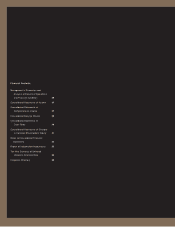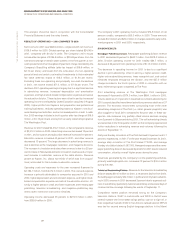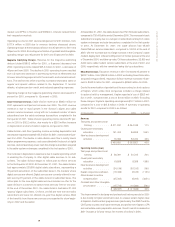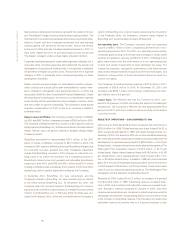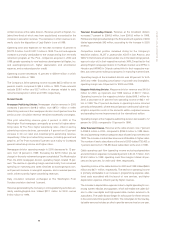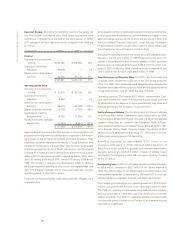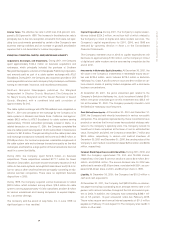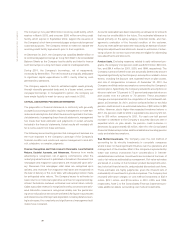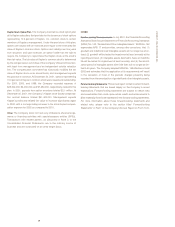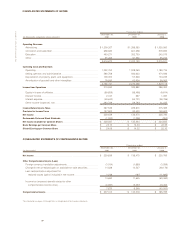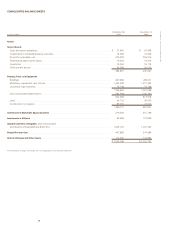Washington Post 2001 Annual Report Download - page 5
Download and view the complete annual report
Please find page 5 of the 2001 Washington Post annual report below. You can navigate through the pages in the report by either clicking on the pages listed below, or by using the keyword search tool below to find specific information within the annual report.
32
THE WASHINGTON POST COMPANY
scriber revenue at the cable division. Revenue growth at Kaplan, Inc.
(about two-thirds of which was from acquisitions) accounted for the
increase in education revenue. The decrease in other revenue is pri-
marily due to the disposition of Legi-Slate in June of 1999.
Operating costs and expenses for the year increased 13 percent to
$2,072.3 million, from $1,827.1 million in 1999. The cost and expense
increase is primarily attributable to the charge arising from the early
retirement program at The Post, companies acquired in 2000 and
1999, greater spending for new business development at Kaplan, Inc.
and washingtonpost.com, higher depreciation and amortization
expense, and a reduced pension credit.
Operating income decreased 13 percent to $339.9 million in 2000,
from $388.5 million in 1999.
The Company’s 2000 operating income includes $65.3 million of net
pension credits, compared to $84.4 million in 1999. These amounts
exclude $29.0 million and $2.7 million in charges related to early
retirement programs in 2000 and 1999, respectively.
Division Results
Newspaper Publishing Division. Newspaper division revenue in 2000
increased 5 percent to $918.2 million, from $875.1 million in 1999.
Advertising revenue at the newspaper division rose 5 percent over the
previous year; circulation revenue remained essentially unchanged.
Total print advertising revenue grew 4 percent in 2000 at The
Washington Post newspaper, principally as a result of higher adver-
tising rates. At The Post, higher advertising rates, offset in part by
advertising volume declines, generated a 4 percent and 2 percent
increase in full run retail and classified print advertising revenue,
respectively. Other print advertising revenue (including general and
preprint) at The Post increased 5 percent due mainly to increased
general advertising volume and higher rates.
Newspaper division operating margin in 2000 decreased to 12 per-
cent, from 18 percent in 1999. Excluding the $27.5 million pre-tax
charge for the early retirement program completed at The Washington
Post, the 2000 newspaper division operating margin totaled 15 per-
cent. The decline in operating margin resulted mostly from increased
spending on marketing and sales initiatives at washingtonpost.com,
an 8 percent increase in newsprint expense, and a reduced pension
credit, offset in part by higher advertising revenues.
Daily circulation remained unchanged at The Washington Post;
Sunday circulation declined 1 percent.
Revenue generated by the Company’s online publishing activities, pri-
marily washingtonpost.com, totaled $27.1 million for 2000, versus
$15.6 million for 1999.
Television Broadcasting Division. Revenue at the broadcast division
increased 7 percent to $364.8 million, from $341.8 million in 1999.
Political and Olympics advertising in the third and fourth quarters of 2000
totaled approximately $42 million, accounting for the increase in 2000
revenue.
Competitive market position remained strong for the Company’s
television stations. WJXT in Jacksonville, KSAT in San Antonio, and
WDIV in Detroit were all ranked number one in the latest ratings period,
sign-on to sign-off, in their respective markets; WPLG was tied for first
among English-language stations in the Miami market; and KPRC in
Houston and WKMG in Orlando ranked third in their respective mar-
kets, but continued to make good progress in improving market share.
Operating margin at the broadcast division was 49 percent for both
2000 and 1999. Excluding amortization of goodwill and intangibles,
operating margin was 53 percent for 2000 and 1999.
Magazine Publishing Division. Magazine division revenue was $416.4
million for 2000, up 4 percent over 1999 revenue of $401.1 million.
Operating income for the magazine division totaled $49.1 million for
2000, a decrease of 21 percent from operating income of $62.1 mil-
lion in 1999. The 21 percent decrease in operating income occurred
primarily at Newsweek, where reduced pension credits and higher sub-
scription acquisition costs at the domestic edition outpaced revenue
and operating income improvements at the international edition.
Operating margin at the magazine publishing division decreased to 12
percent for 2000, compared to 15 percent in 1999.
Cable Television Division. Revenue at the cable division rose 7 percent
to $358.9 million in 2000, compared to $336.3 million in 1999. Basic,
tier, and advertising revenue categories each showed improvement over
1999. The increase in subscriber revenue is attributable to higher rates.
The number of basic subscribers at the end of 2000 totaled 735,400, a
1 percent decline from 739,850 basic subscribers at the end of 1999.
Cable operating cash flow (operating income excluding depreciation
and amortization expense) increased 2 percent to $143.7 million, from
$140.2 million in 1999; operating cash flow margins totaled 40 per-
cent and 42 percent, for 2000 and 1999, respectively.
Operating income at the cable division for 2000 and 1999 totaled $66.0
million and $67.1 million, respectively. The decline in operating income
is primarily attributable to an increase in programming expense, addi-
tional costs associated with the launch of new services, and higher
depreciation expense, offset in part by higher revenue.
The increase in depreciation expense is due to capital spending for con-
tinuing system rebuilds and upgrades, which will enable the cable divi-
sion to offer new digital and high-speed cable modem services to its
subscribers. The cable division began its rollout plan for these services
in the second and third quarters of 2000. The rollout plan for the new dig-
ital cable services includes an offer to provide services free for one year.

